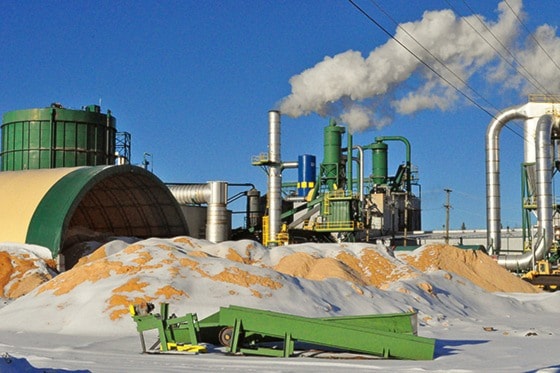The L&M Lumber mill has finished installing a cogeneration unit to convert waste heat into energy and additional revenue.
Called an Organic Rankine Cycle (ORC) turbogenerator, the unit is the first of its kind in Canada to be powered off waste heat at a sawmill, said Alan Fitzpatrick, general manager and director of L&M Lumber, Nechako Lumber and Premium Pellet Ltd.
Installation of the unit is part of a perpetual shift towards developing a more energy-efficient mill, explained Fitzpatrick, who implemented and installed the turbogenerator under a newly formed company, Nechako Green Energy Ltd.
Powered by waste heat emitted from the mill's current thermal energy system, which burns bark to dry lumber in a kiln, the ORC turbogenerator can produce up to 20 megawatts of electricity, enough energy to power about 1,500 homes, which is roughly the size of Vanderhoof.
Prior to installing the unit, excess heat was being lost, venting into the atmosphere, explained Fitzpatrick.
By harnessing it with the ORC unit, L&M Lumber expects to produce about 30 per cent of the energy currently being consumed by the mill, saving up to $1 million annually.
"The basic purpose was to become more efficient and energy self sufficient, reduce our footprint and create a revenue stream from a waste item," Fitzpatrick stated in an email on March 1.
Sustainable operations and reducing waste have long been top priorities for L&M Lumber, a Vanderhoof-based company that produces high-quality lumber for markets in Canada, the U.S., Japan, South Korea, the U.K. and the Netherlands.
Fitzpatrick said the mill utilizes all materials on site, turning logs and byproduct into either lumber, wood chips, wood pellets, heat and, now, electricity.
"There is virtually no waste of fibre on our site. We have the most up to date and advanced scanning and optimizing equipment for lumber production in the world," he said.
More than six years have passed since Fitzpatrick began investigating solutions for harnessing waste heat to when he started the ORC turbogenerator for the first time on Feb. 19.
During the same time period, Fitzpatrick negotiated a Load Displacement contract with B.C. Hydro to sell excess energy generated by the ORC unit, further reducing the mill's electricity rates.
"In my opinion we have taken cheap power for granted in this province," said Fitzpatrick.
"Energy is becoming more expensive and harder to get, so self generation from a waste stream makes a lot of sense environmentally and economically."
